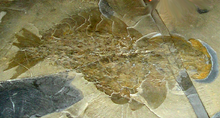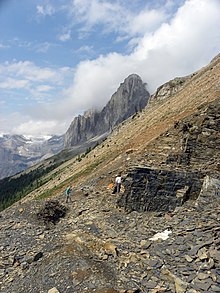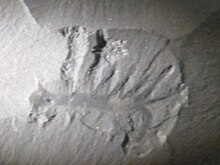Burgess slate

The Burgess Shale ( English Burgess shale ) is one of the world's most important fossil sites and was after Burgess Pass in Yoho National Park in the Canadian Rockies named on the southwestern saddle between Mount Wapta and Mountfield.
What is meant is a site of sediments - mainly in two quarries (Walcott Quarry and the higher-lying Raymond Quarry) - which were discovered near Field ( British Columbia , Canada) on August 30, 1909 by Charles Doolittle Walcott and are a World Heritage Site . Due to the extraordinary formation process more than 200 meters below sea level at the time of the Middle Cambrian about 505 million years ago (at that time near the equator), extremely rare fossils of animal, shell-less organisms can be found here in large numbers. The thin layer of slate therefore represents a window onto the wealth of a Central Cambrian ecosystem, which is one of the most vital times in the development of life on earth. The finds include fossils of more than 30 genera of arthropods and a large number of bristle worms , the fine structures of which have been preserved in pristine condition in the fine-grained sediments. Pikaia gracilens is mostly regarded as one of the oldest known chordates . Other fossils elude today's systematics, completely new, today no longer represented strains are proposed for them. Similar finds from this period are known from the Chengjiang Fauna Community in the Chinese province of Yunnan .
The Burgess slate is considered to be a "treasure trove" due to the unusual preservation of the soft tissue of the numerous fossils and its essential importance for research into the early evolution of multicellular animals (Metazoa) among paleontologists and paleoecologists , because it enables a globally unique insight into a Cambrian biocenosis .
History and meaning

The discovery by Charles Walcott
The Burgess Shale was discovered in 1909 by paleontologist Charles Walcott just before the end of the excavation season. Occasionally it is said that his wife's horse tripped over a boulder while descending the steep path that branches off the ridge between Mount Wapta and Mount Field in what is now Yoho National Park. When Charles Walcott smashed the boulder to make the path safer, he exposed a Marrella fossil. The romantic story, however, is not corroborated by Walcott's diary entries. The discovery of the first fossils by Walcott can be dated to September 1909.
In 1910 Charles Walcott returned with his sons to begin excavations in the fossil-rich rock. The amount of unknown fossils and their extraordinary preservation of soft tissues prompted him to return to the quarry he established almost every year until 1924. By this time, at the age of 74, he had amassed 65,000 fossil specimens. Describing these fossils was an extremely time-consuming task that he pursued until his death in 1927. Walcott tried, as was customary in his time, to include all fossil finds in the systematics of modern animal species. As a result, the fossils were then viewed as curiosities. Charles Walcott's collection is now in the Smithsonian .
Research history since the 1960s
It was only when Alberto Simonetta re-examined the fossils in 1962 that the extraordinary value of the Burgess slate for science and the problem that the organisms could not be easily incorporated into the systematics of modern species was recognized. The excavations in Walcott's quarry were resumed by the Geological Survey of Canada in 1966 , after persuasion by trilobite expert Harry Blackmore Whittington . A second outcrop, known as the Raymond Quarry, was also constructed about 20 m above the Walcott Quarry. Harvard professor Percy E. Raymond carried out extensive excavations here in the 1930s. The collection is now in the Museum of Comparative Zoology at Harvard.
Whittington, along with his students Derek Briggs and Simon Conway Morris of the University of Cambridge , began a thorough reassessment of the Burgess shale and discovered that the fossil fauna was much more diverse and unusual than Walcott had recognized in his day. Indeed, many of the fossils found had strange anatomical properties and only vague similarities to modern animals. Examples are Opabinia , with five eyes and a trunk-like elongated head, as well as Hallucigenia , which was originally reconstructed upside down and so ran on its bilaterally symmetrically arranged spines. It is now assumed that it moved on fleshy appendages attached to the trunk, similar to today's velvet worms . Nectocaris , originally described as a crustacean with fins or a chordate with a shell , has since been identified as an early cephalopod .
After Parks Canada and UNESCO recognized the importance of Burgess Shale around 1970, collecting fossils became more difficult. Further digs were carried out by the Royal Ontario Museum . The curator of invertebrate enpaläontologie Desmond Collins identified a number of other clues the Burgess Shale, the stratigraphically are both above and below the original Walcott Quarry. These revelations continue to yield novel fossils faster than they can be examined.
The book Wonderful Life , published in 1989 by Stephen Jay Gould , brought the fossils of Burgess Shale to public attention. Gould believed that the extraordinary diversity of the Burgess fossils suggested that the Cambrian environment was much more sculptural than it is today, and that many of the unique lineages were evolutionary experiments that became extinct. Gould's thesis was based very heavily on the original works by Walcott, which were reinterpreted by Simon Conway Morris. Morris, however, disagreed with Gould's conclusions. In his opinion, almost the entire Burgess fauna could be incorporated into today's system.
Geological framework

The fossil-rich deposits of Burgess Shale are part of the Stephen Formation , a series of slightly calcareous, dark clay stones . Their age is around 505 million years. The individual layers were deposited at the base of a 160 m high steep slope (reef), under the storm wave base . The steep slope is made up of calcareous reef deposits and is part of the cathedral formation . This formation is believed to have formed shortly before the Burgess slate was deposited. The exact course of the sediment formation is not known with certainty, but the most widespread hypothesis assumes that the upper part of the reef was detached and with it, in the form of a suspension stream , the clays of the Stephen Formation slid into the depths, and may not have been deposited again until miles away from the reef front . The reactivation of faults at the base of the formation about 509 million years ago is considered to be the cause of the partial disintegration of the Cathedral Formation . The rocks of the Cathedral Formation are very resistant to tectonic loads. They therefore offered the deposits of the Stephen Formation on top of it protection from such processes. This explains why fossil finds in the Stephen Formation that were made at a greater distance from the former reef are not usable. Due to the tectonic processes, the rock breaks vertically to form the fossils. Walcott's Quarry produced so many spectacular fossils because it was so close to the Stephen Formation. In fact, the quarry has now been excavated to such an extent that the Cathedral Formation has been found.
Originally it was believed that Burgess shale was deposited under anoxic conditions, but recent research shows that oxygen was present in the sediment at all times . The absence of oxygen, it was assumed, would protect the dead organisms from decomposition and create chemical conditions that would enable the soft tissues to be transmitted. In addition, as the oxygen content of the water decreases, the number of burrowing organisms also decreases. Ichnofossils have been found in the layers with soft tissue preservation , but these are rare and relatively small. Another hypothesis makes highly saline solutions on the ocean floor responsible for the extraordinary conservation.
stratigraphy
The formation of the Burgess slate consists of 10 different sub-formations (English: members ). The most famous subformation is the Walcott Quarry Shale Member , which in turn contains the Phyllopod Beds .
Taphonomy and Diagenesis
There are many other fossil sites of similar fossil conservation status; in fact, such fossil collections are much more common in the Cambrian than in any later period in the earth's history . Taphonomy seeks the cause for this in the very limited extent of bioturbation . Over the course of the Cambrian, the number of burrowing organisms increased and, as a result, the likelihood of fossil soft tissue preservation decreased.
Similar references
The fossil sites most commonly used for comparison with the Burgess Shale are Sirius Passet in Greenland and Chengjiang in southern China.
Organisms
The biota of the Burgess slate appears to be typical of sediments of the Middle Cambrian. Although skeletal organisms only make up 14% of the fossil community, very similar proportions are found in other Cambrian fossil sites. So there is no reason to accept non-skeletal organisms as special in any way. In fact, many have also been identified from other fossil sites of different locations and ages.
The biota are made up of very different organisms. Free-swimming ( nectonic ) organisms are relatively rare, benthonic representatives make up the majority. These include mobile and sessile species. Over 2/3 of the organisms fed on organic material on or in the sediment ( detritivor ), almost 1/3 filtered fine particles from the water column ( suspensivor ) and less than 10% were carnivorous or scavengers ( necrophagous ). The benthonic representatives are divided into fixed or sessile epifauna (about 30 percent) and mobile epifauna (about 40 percent of the total fauna), which crawled or crawled across the seabed. The sessile animals are mainly sponges. The motile epifauna was more diverse overall and was dominated by arthropods . Animals that lived above the sediment surface are rare and only make up about 10 percent of the finds. The reason for their rarity is that they were better able to escape the currents of mud than swimmers.
See also
supporting documents
literature
- Stephen Jay Gould: Chance Man. The miracle of life as a game of nature . Hanser , Munich 1993, ISBN 3-446-15951-7 .
- Showdown on the Burgess Shale. Natural History magazine, 107 (10): 48-55, accessed November 1, 2011 (Gould and Conway Morris discuss the importance of Burgess slate).
- Simon Conway Morris: The Crucible of Creation. The Burgess Shale and the Rise of Animals . Oxford University Press, Oxford 1998, ISBN 0-19-850197-8 .
- Richard Fortey: Trilobite. Eyewitness to Evolution . Flamingo, London 2001, ISBN 0-00-655138-6 .
- Stephen Jay Gould: Wonderful Life. Burgess Shale and the Nature of History . Vintage, London et al. 2000, ISBN 0-09-927345-4 .
- Derek EG Briggs, Douglas H. Erwin, Frederick J. Collier: The Fossils of the Burgess Shale . Smithsonian, Washington DC 1994, ISBN 1-56098-364-7 .
Web links
- Description of the site and some fossils on www.sauti.de
- The Burgess Shale Geoscience Foundation (English)
- Burgess Slate Datasheet in the Paleobiology Database
Individual evidence
- ^ Age of Burgess Shale . In: Burgess Shale . Bristol University. Archived from the original on July 14, 2007. Info: The archive link was inserted automatically and has not yet been checked. Please check the original and archive link according to the instructions and then remove this notice. Retrieved September 5, 2007.
- ↑ a b c d e f g h i j k l m n o p q r D. EG Briggs, DH Erwin, FJ Collier: Fossils of the Burgess Shale . Smithsonian Inst Press, Washington 1995, ISBN 1-56098-659-X .
- ↑ Paul Selden , John Nudds: Windows on Evolution - Famous Fossil Findings in the World. Elsevier, Munich 2007, ISBN 978-3-8274-1771-8 , p. 20.
- ↑ Paul Selden, John Nudds: Windows on Evolution - Famous Fossil Findings in the World. Elsevier, Munich 2007, ISBN 978-3-8274-1771-8 , p. 21.
- ^ Simon Conway Morris: The Crucible of Creation. The Burgess Shale and the Rise of Animals. Oxford University Press, Oxford 1998, ISBN 0-19-850256-7 , pp. 242 .
- ↑ a b S. E. Gabbott, J. Zalasiewicz, D. Collins: sedimentation of the Phyllopod Bed within the Cambrian Burgess Shale of British Columbia . In: Journal of Geological Society . tape 165 , no. 1 , 2008, p. 307 , doi : 10.1144 / 0016-76492007-023 ( online at Lyell Collection.org ).
- ↑ CJ Collom: reinterpretation of 'middleware' Cambrian stratigraphy of the rifted western Laurentian margin: Burgess Shale Formation and contiguous units (Sauk II Megasequence); Rocky Mountains, Canada. In: Palaeogeography Palaeoclimatology Palaeoecology . tape 277 , no. 1-2 , 2009, pp. 63–85 , doi : 10.1016 / j.palaeo.2009.02.012 .
- ^ W. Powell: Comparison of Geochemical and Distinctive Mineralogical Features Associated with the Kinzers and Burgess Shale Formations and their Associated Units . In: Palaeogeography Palaeoclimatology Palaeoecology . tape 277 , no. 1-2 , 2009, pp. 127–140 , doi : 10.1016 / j.palaeo.2009.02.016 .
- ↑ Paul Selden, John Nudds: Windows on Evolution - Famous Fossil Findings in the World. Elsevier, Munich 2007, ISBN 978-3-8274-1771-8 , p. 27 and p. 28.
- ↑ Paul Selden, John Nudds: Windows on Evolution - Famous Fossil Findings in the World. Elsevier, Munich 2007, ISBN 978-3-8274-1771-8 , p. 27.
Coordinates: 51 ° 26 '18 " N , 116 ° 28' 36" W.


